Conflict Management Strategies and Techniques: A Detailed Report
VerifiedAdded on 2023/01/04
|11
|3078
|24
Report
AI Summary
This report delves into the multifaceted domain of conflict management, providing a comprehensive analysis of its various dimensions within an organizational context, specifically referencing Morrison, a leading UK supermarket chain. The report begins by defining conflict, highlighting its diverse forms, including interpersonal, intergroup, and organizational conflicts, and outlines the stages through which conflicts typically escalate. It examines the impact of conflicts on organizational functions, encompassing profitability, productivity, and employee performance. The core of the report focuses on conflict management styles such as accommodating, avoiding, compromising, competing, and collaborating, evaluating their positive and negative impacts. Furthermore, it explores conflict resolution techniques, emphasizing the roles of coaching and mentoring in fostering effective communication and problem-solving. The report aims to equip readers with practical insights and strategies for navigating and resolving workplace conflicts, ultimately enhancing organizational effectiveness and employee relations.
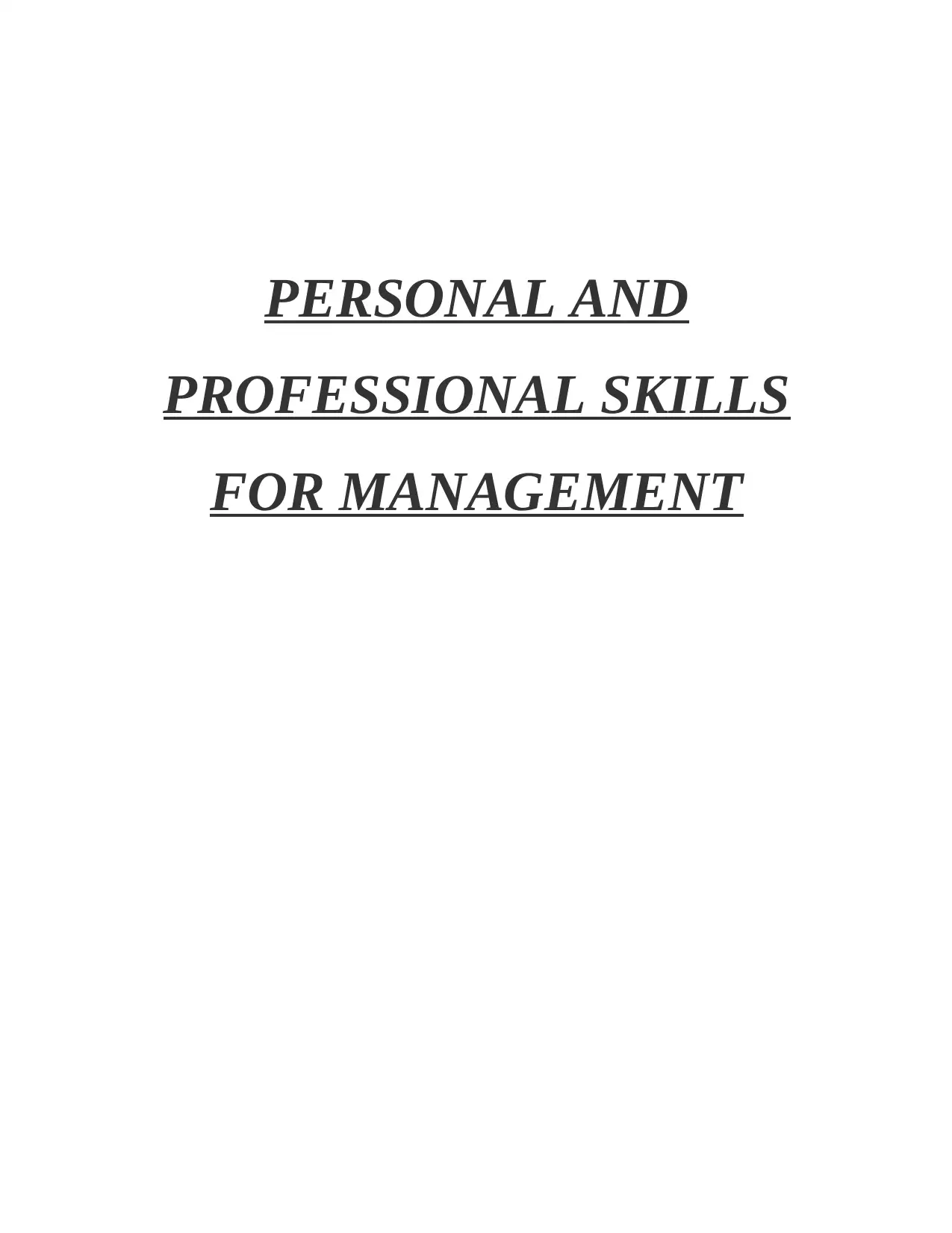
PERSONAL AND
PROFESSIONAL SKILLS
FOR MANAGEMENT
PROFESSIONAL SKILLS
FOR MANAGEMENT
Paraphrase This Document
Need a fresh take? Get an instant paraphrase of this document with our AI Paraphraser

Table of Contents
INTRODUCTION...........................................................................................................................3
Conflict:......................................................................................................................................4
Different types of conflicts and stages of conflicts. ...................................................................4
Impact of conflict in order to organisation affected their functions. ........................................6
Conflict management and various styles .................................................................................6
Conflict resolution and elaborates their techniques. .................................................................8
Coaching and mentoring ............................................................................................................8
CONCLUSION ............................................................................................................................10
REFERENCES .............................................................................................................................10
INTRODUCTION...........................................................................................................................3
Conflict:......................................................................................................................................4
Different types of conflicts and stages of conflicts. ...................................................................4
Impact of conflict in order to organisation affected their functions. ........................................6
Conflict management and various styles .................................................................................6
Conflict resolution and elaborates their techniques. .................................................................8
Coaching and mentoring ............................................................................................................8
CONCLUSION ............................................................................................................................10
REFERENCES .............................................................................................................................10
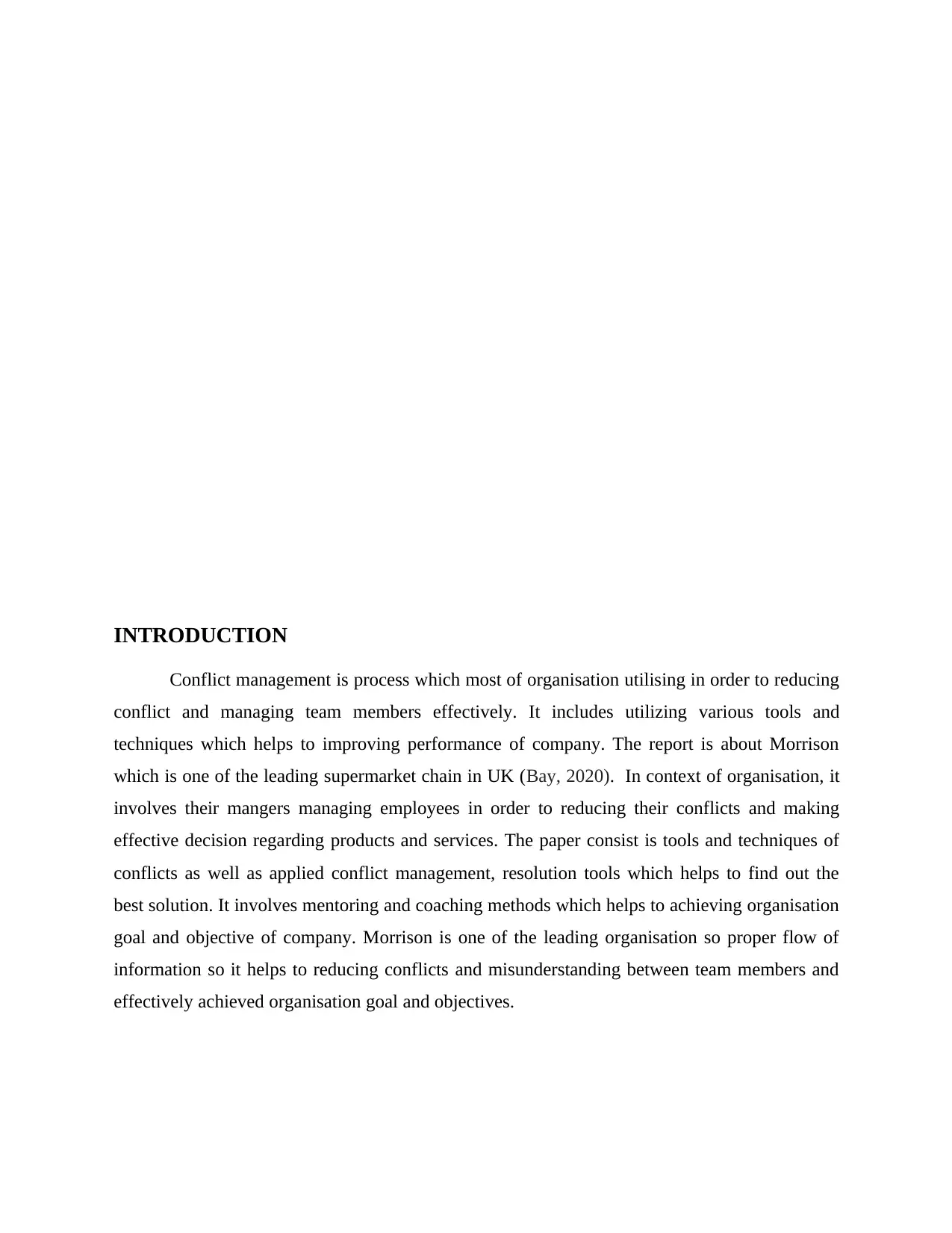
INTRODUCTION
Conflict management is process which most of organisation utilising in order to reducing
conflict and managing team members effectively. It includes utilizing various tools and
techniques which helps to improving performance of company. The report is about Morrison
which is one of the leading supermarket chain in UK (Bay, 2020). In context of organisation, it
involves their mangers managing employees in order to reducing their conflicts and making
effective decision regarding products and services. The paper consist is tools and techniques of
conflicts as well as applied conflict management, resolution tools which helps to find out the
best solution. It involves mentoring and coaching methods which helps to achieving organisation
goal and objective of company. Morrison is one of the leading organisation so proper flow of
information so it helps to reducing conflicts and misunderstanding between team members and
effectively achieved organisation goal and objectives.
Conflict management is process which most of organisation utilising in order to reducing
conflict and managing team members effectively. It includes utilizing various tools and
techniques which helps to improving performance of company. The report is about Morrison
which is one of the leading supermarket chain in UK (Bay, 2020). In context of organisation, it
involves their mangers managing employees in order to reducing their conflicts and making
effective decision regarding products and services. The paper consist is tools and techniques of
conflicts as well as applied conflict management, resolution tools which helps to find out the
best solution. It involves mentoring and coaching methods which helps to achieving organisation
goal and objective of company. Morrison is one of the leading organisation so proper flow of
information so it helps to reducing conflicts and misunderstanding between team members and
effectively achieved organisation goal and objectives.
⊘ This is a preview!⊘
Do you want full access?
Subscribe today to unlock all pages.

Trusted by 1+ million students worldwide
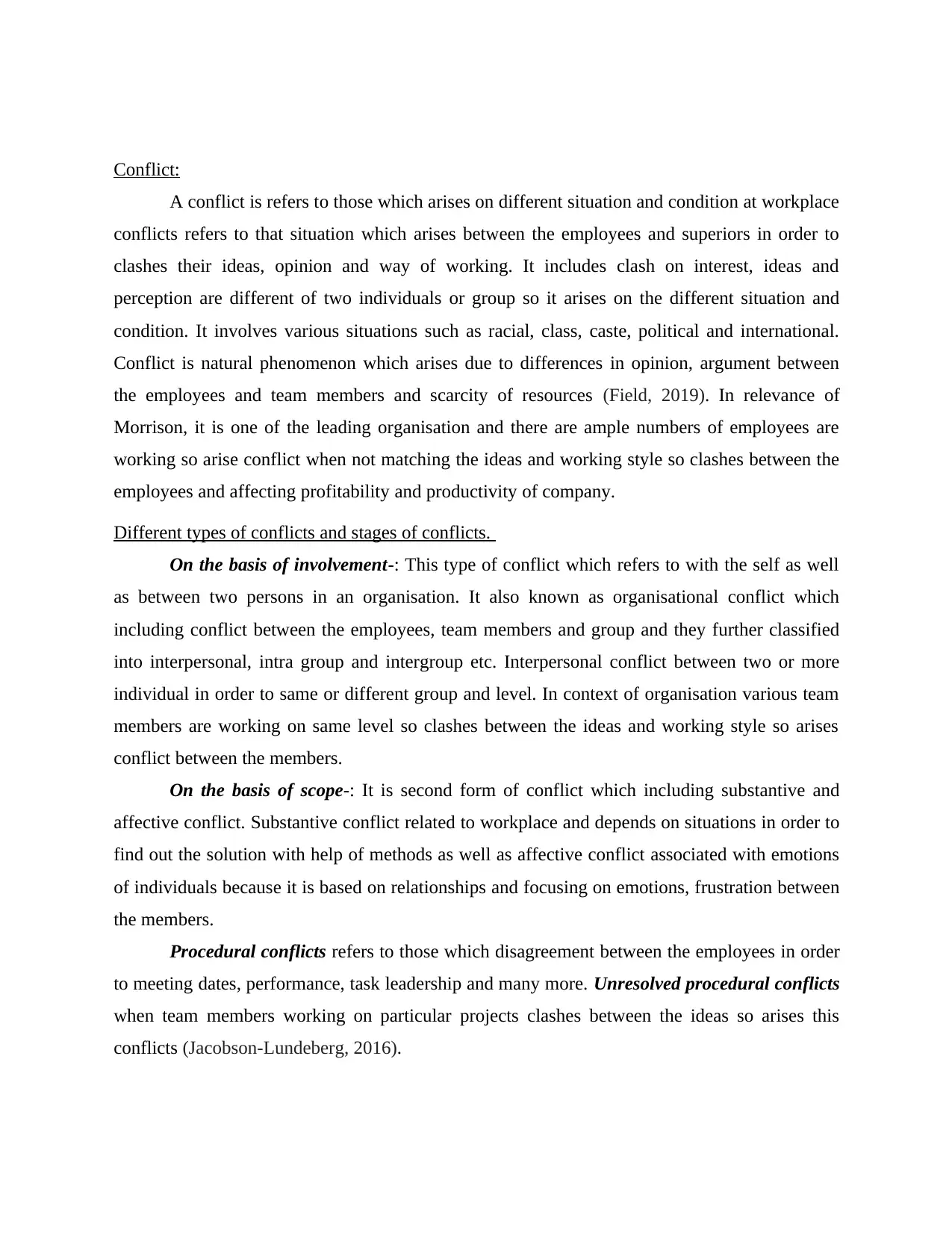
Conflict:
A conflict is refers to those which arises on different situation and condition at workplace
conflicts refers to that situation which arises between the employees and superiors in order to
clashes their ideas, opinion and way of working. It includes clash on interest, ideas and
perception are different of two individuals or group so it arises on the different situation and
condition. It involves various situations such as racial, class, caste, political and international.
Conflict is natural phenomenon which arises due to differences in opinion, argument between
the employees and team members and scarcity of resources (Field, 2019). In relevance of
Morrison, it is one of the leading organisation and there are ample numbers of employees are
working so arise conflict when not matching the ideas and working style so clashes between the
employees and affecting profitability and productivity of company.
Different types of conflicts and stages of conflicts.
On the basis of involvement-: This type of conflict which refers to with the self as well
as between two persons in an organisation. It also known as organisational conflict which
including conflict between the employees, team members and group and they further classified
into interpersonal, intra group and intergroup etc. Interpersonal conflict between two or more
individual in order to same or different group and level. In context of organisation various team
members are working on same level so clashes between the ideas and working style so arises
conflict between the members.
On the basis of scope-: It is second form of conflict which including substantive and
affective conflict. Substantive conflict related to workplace and depends on situations in order to
find out the solution with help of methods as well as affective conflict associated with emotions
of individuals because it is based on relationships and focusing on emotions, frustration between
the members.
Procedural conflicts refers to those which disagreement between the employees in order
to meeting dates, performance, task leadership and many more. Unresolved procedural conflicts
when team members working on particular projects clashes between the ideas so arises this
conflicts (Jacobson-Lundeberg, 2016).
A conflict is refers to those which arises on different situation and condition at workplace
conflicts refers to that situation which arises between the employees and superiors in order to
clashes their ideas, opinion and way of working. It includes clash on interest, ideas and
perception are different of two individuals or group so it arises on the different situation and
condition. It involves various situations such as racial, class, caste, political and international.
Conflict is natural phenomenon which arises due to differences in opinion, argument between
the employees and team members and scarcity of resources (Field, 2019). In relevance of
Morrison, it is one of the leading organisation and there are ample numbers of employees are
working so arise conflict when not matching the ideas and working style so clashes between the
employees and affecting profitability and productivity of company.
Different types of conflicts and stages of conflicts.
On the basis of involvement-: This type of conflict which refers to with the self as well
as between two persons in an organisation. It also known as organisational conflict which
including conflict between the employees, team members and group and they further classified
into interpersonal, intra group and intergroup etc. Interpersonal conflict between two or more
individual in order to same or different group and level. In context of organisation various team
members are working on same level so clashes between the ideas and working style so arises
conflict between the members.
On the basis of scope-: It is second form of conflict which including substantive and
affective conflict. Substantive conflict related to workplace and depends on situations in order to
find out the solution with help of methods as well as affective conflict associated with emotions
of individuals because it is based on relationships and focusing on emotions, frustration between
the members.
Procedural conflicts refers to those which disagreement between the employees in order
to meeting dates, performance, task leadership and many more. Unresolved procedural conflicts
when team members working on particular projects clashes between the ideas so arises this
conflicts (Jacobson-Lundeberg, 2016).
Paraphrase This Document
Need a fresh take? Get an instant paraphrase of this document with our AI Paraphraser
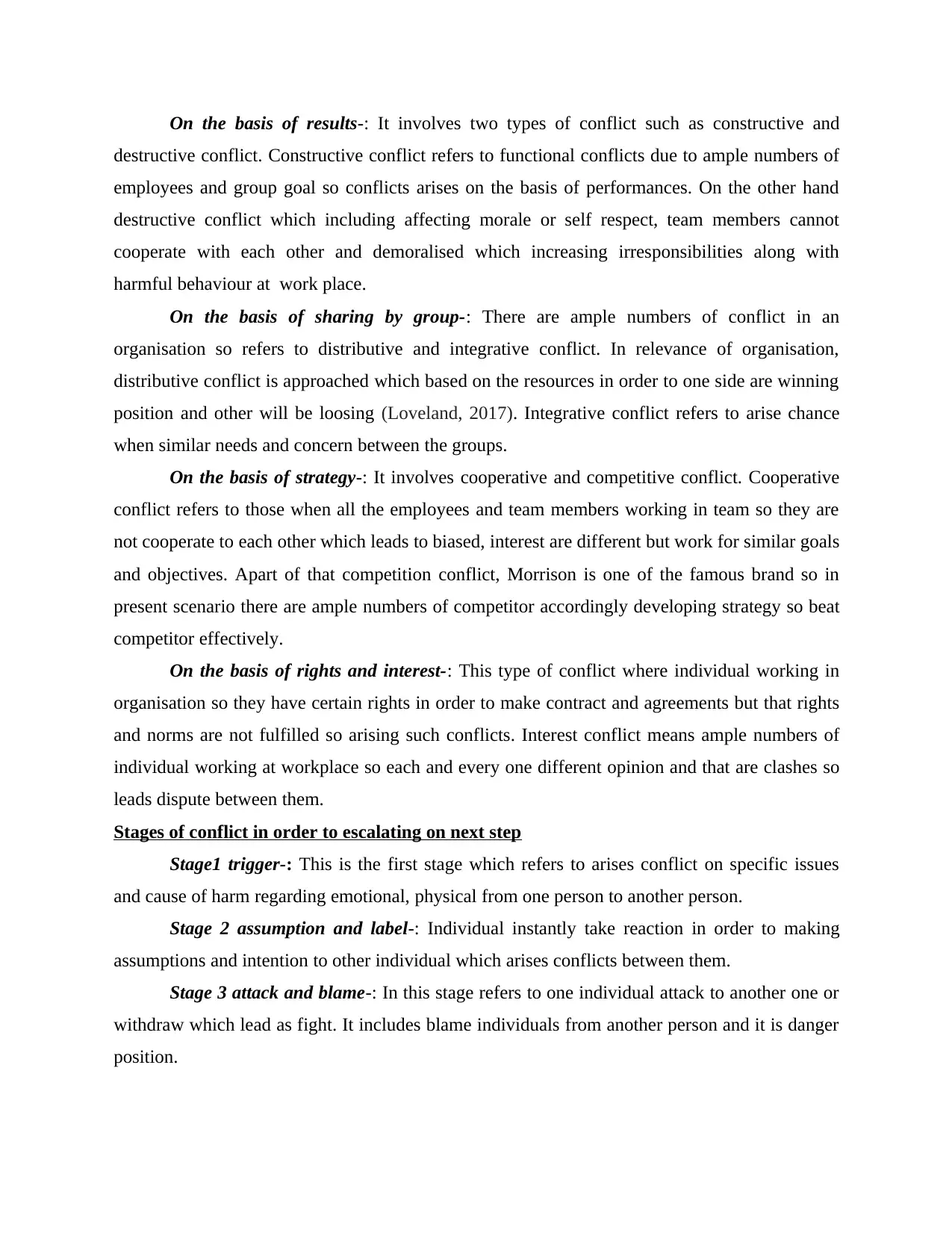
On the basis of results-: It involves two types of conflict such as constructive and
destructive conflict. Constructive conflict refers to functional conflicts due to ample numbers of
employees and group goal so conflicts arises on the basis of performances. On the other hand
destructive conflict which including affecting morale or self respect, team members cannot
cooperate with each other and demoralised which increasing irresponsibilities along with
harmful behaviour at work place.
On the basis of sharing by group-: There are ample numbers of conflict in an
organisation so refers to distributive and integrative conflict. In relevance of organisation,
distributive conflict is approached which based on the resources in order to one side are winning
position and other will be loosing (Loveland, 2017). Integrative conflict refers to arise chance
when similar needs and concern between the groups.
On the basis of strategy-: It involves cooperative and competitive conflict. Cooperative
conflict refers to those when all the employees and team members working in team so they are
not cooperate to each other which leads to biased, interest are different but work for similar goals
and objectives. Apart of that competition conflict, Morrison is one of the famous brand so in
present scenario there are ample numbers of competitor accordingly developing strategy so beat
competitor effectively.
On the basis of rights and interest-: This type of conflict where individual working in
organisation so they have certain rights in order to make contract and agreements but that rights
and norms are not fulfilled so arising such conflicts. Interest conflict means ample numbers of
individual working at workplace so each and every one different opinion and that are clashes so
leads dispute between them.
Stages of conflict in order to escalating on next step
Stage1 trigger-: This is the first stage which refers to arises conflict on specific issues
and cause of harm regarding emotional, physical from one person to another person.
Stage 2 assumption and label-: Individual instantly take reaction in order to making
assumptions and intention to other individual which arises conflicts between them.
Stage 3 attack and blame-: In this stage refers to one individual attack to another one or
withdraw which lead as fight. It includes blame individuals from another person and it is danger
position.
destructive conflict. Constructive conflict refers to functional conflicts due to ample numbers of
employees and group goal so conflicts arises on the basis of performances. On the other hand
destructive conflict which including affecting morale or self respect, team members cannot
cooperate with each other and demoralised which increasing irresponsibilities along with
harmful behaviour at work place.
On the basis of sharing by group-: There are ample numbers of conflict in an
organisation so refers to distributive and integrative conflict. In relevance of organisation,
distributive conflict is approached which based on the resources in order to one side are winning
position and other will be loosing (Loveland, 2017). Integrative conflict refers to arise chance
when similar needs and concern between the groups.
On the basis of strategy-: It involves cooperative and competitive conflict. Cooperative
conflict refers to those when all the employees and team members working in team so they are
not cooperate to each other which leads to biased, interest are different but work for similar goals
and objectives. Apart of that competition conflict, Morrison is one of the famous brand so in
present scenario there are ample numbers of competitor accordingly developing strategy so beat
competitor effectively.
On the basis of rights and interest-: This type of conflict where individual working in
organisation so they have certain rights in order to make contract and agreements but that rights
and norms are not fulfilled so arising such conflicts. Interest conflict means ample numbers of
individual working at workplace so each and every one different opinion and that are clashes so
leads dispute between them.
Stages of conflict in order to escalating on next step
Stage1 trigger-: This is the first stage which refers to arises conflict on specific issues
and cause of harm regarding emotional, physical from one person to another person.
Stage 2 assumption and label-: Individual instantly take reaction in order to making
assumptions and intention to other individual which arises conflicts between them.
Stage 3 attack and blame-: In this stage refers to one individual attack to another one or
withdraw which lead as fight. It includes blame individuals from another person and it is danger
position.
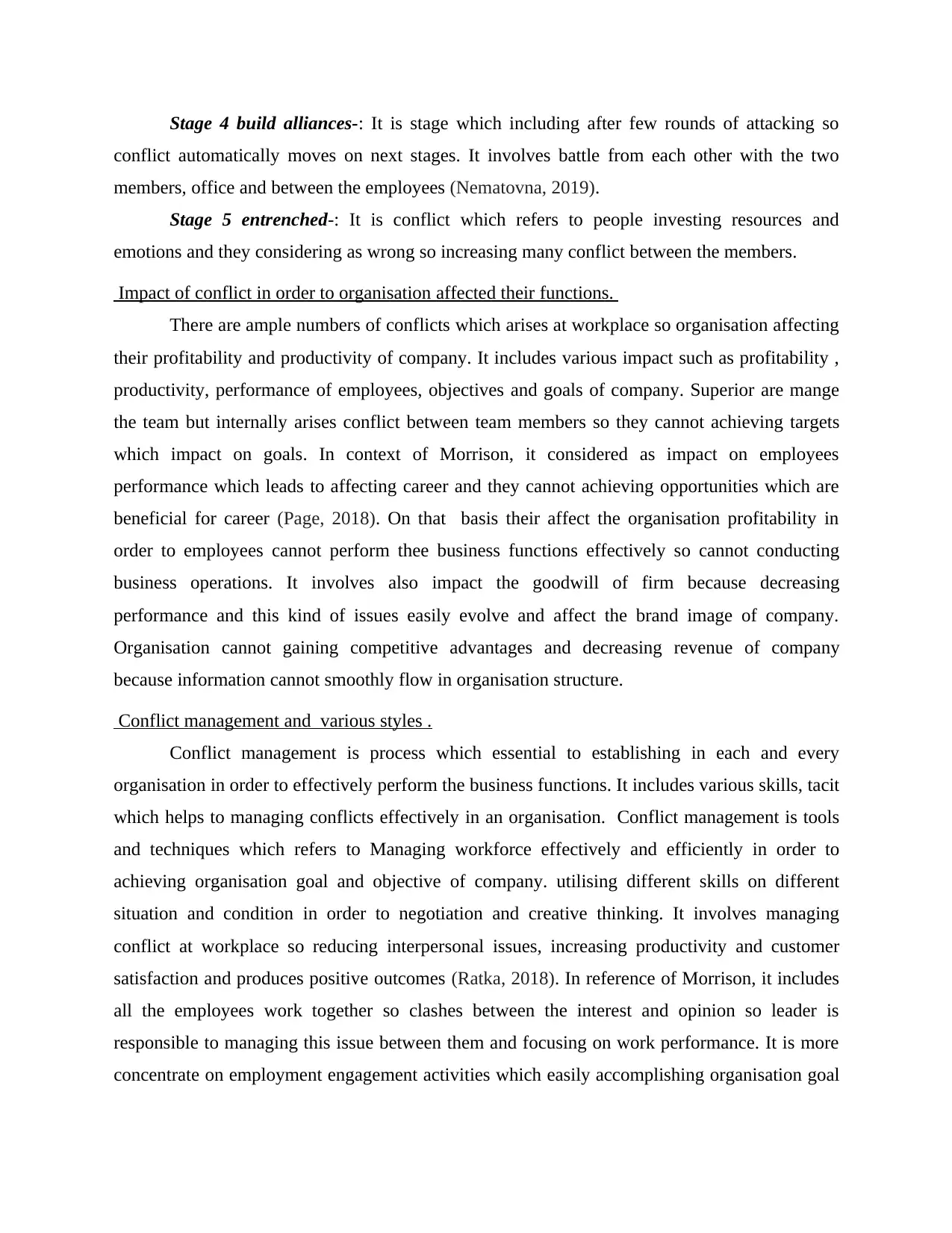
Stage 4 build alliances-: It is stage which including after few rounds of attacking so
conflict automatically moves on next stages. It involves battle from each other with the two
members, office and between the employees (Nematovna, 2019).
Stage 5 entrenched-: It is conflict which refers to people investing resources and
emotions and they considering as wrong so increasing many conflict between the members.
Impact of conflict in order to organisation affected their functions.
There are ample numbers of conflicts which arises at workplace so organisation affecting
their profitability and productivity of company. It includes various impact such as profitability ,
productivity, performance of employees, objectives and goals of company. Superior are mange
the team but internally arises conflict between team members so they cannot achieving targets
which impact on goals. In context of Morrison, it considered as impact on employees
performance which leads to affecting career and they cannot achieving opportunities which are
beneficial for career (Page, 2018). On that basis their affect the organisation profitability in
order to employees cannot perform thee business functions effectively so cannot conducting
business operations. It involves also impact the goodwill of firm because decreasing
performance and this kind of issues easily evolve and affect the brand image of company.
Organisation cannot gaining competitive advantages and decreasing revenue of company
because information cannot smoothly flow in organisation structure.
Conflict management and various styles .
Conflict management is process which essential to establishing in each and every
organisation in order to effectively perform the business functions. It includes various skills, tacit
which helps to managing conflicts effectively in an organisation. Conflict management is tools
and techniques which refers to Managing workforce effectively and efficiently in order to
achieving organisation goal and objective of company. utilising different skills on different
situation and condition in order to negotiation and creative thinking. It involves managing
conflict at workplace so reducing interpersonal issues, increasing productivity and customer
satisfaction and produces positive outcomes (Ratka, 2018). In reference of Morrison, it includes
all the employees work together so clashes between the interest and opinion so leader is
responsible to managing this issue between them and focusing on work performance. It is more
concentrate on employment engagement activities which easily accomplishing organisation goal
conflict automatically moves on next stages. It involves battle from each other with the two
members, office and between the employees (Nematovna, 2019).
Stage 5 entrenched-: It is conflict which refers to people investing resources and
emotions and they considering as wrong so increasing many conflict between the members.
Impact of conflict in order to organisation affected their functions.
There are ample numbers of conflicts which arises at workplace so organisation affecting
their profitability and productivity of company. It includes various impact such as profitability ,
productivity, performance of employees, objectives and goals of company. Superior are mange
the team but internally arises conflict between team members so they cannot achieving targets
which impact on goals. In context of Morrison, it considered as impact on employees
performance which leads to affecting career and they cannot achieving opportunities which are
beneficial for career (Page, 2018). On that basis their affect the organisation profitability in
order to employees cannot perform thee business functions effectively so cannot conducting
business operations. It involves also impact the goodwill of firm because decreasing
performance and this kind of issues easily evolve and affect the brand image of company.
Organisation cannot gaining competitive advantages and decreasing revenue of company
because information cannot smoothly flow in organisation structure.
Conflict management and various styles .
Conflict management is process which essential to establishing in each and every
organisation in order to effectively perform the business functions. It includes various skills, tacit
which helps to managing conflicts effectively in an organisation. Conflict management is tools
and techniques which refers to Managing workforce effectively and efficiently in order to
achieving organisation goal and objective of company. utilising different skills on different
situation and condition in order to negotiation and creative thinking. It involves managing
conflict at workplace so reducing interpersonal issues, increasing productivity and customer
satisfaction and produces positive outcomes (Ratka, 2018). In reference of Morrison, it includes
all the employees work together so clashes between the interest and opinion so leader is
responsible to managing this issue between them and focusing on work performance. It is more
concentrate on employment engagement activities which easily accomplishing organisation goal
⊘ This is a preview!⊘
Do you want full access?
Subscribe today to unlock all pages.

Trusted by 1+ million students worldwide
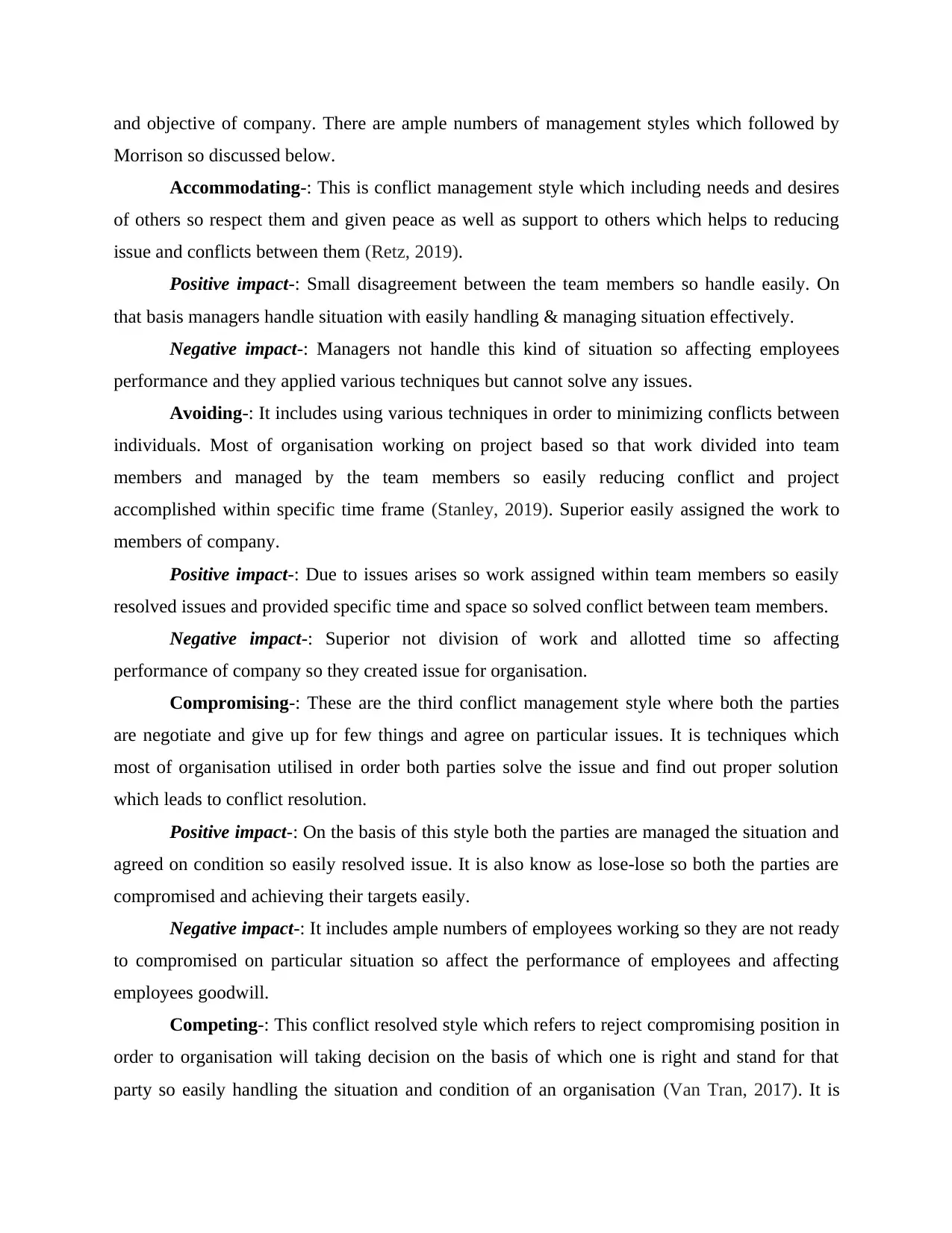
and objective of company. There are ample numbers of management styles which followed by
Morrison so discussed below.
Accommodating-: This is conflict management style which including needs and desires
of others so respect them and given peace as well as support to others which helps to reducing
issue and conflicts between them (Retz, 2019).
Positive impact-: Small disagreement between the team members so handle easily. On
that basis managers handle situation with easily handling & managing situation effectively.
Negative impact-: Managers not handle this kind of situation so affecting employees
performance and they applied various techniques but cannot solve any issues.
Avoiding-: It includes using various techniques in order to minimizing conflicts between
individuals. Most of organisation working on project based so that work divided into team
members and managed by the team members so easily reducing conflict and project
accomplished within specific time frame (Stanley, 2019). Superior easily assigned the work to
members of company.
Positive impact-: Due to issues arises so work assigned within team members so easily
resolved issues and provided specific time and space so solved conflict between team members.
Negative impact-: Superior not division of work and allotted time so affecting
performance of company so they created issue for organisation.
Compromising-: These are the third conflict management style where both the parties
are negotiate and give up for few things and agree on particular issues. It is techniques which
most of organisation utilised in order both parties solve the issue and find out proper solution
which leads to conflict resolution.
Positive impact-: On the basis of this style both the parties are managed the situation and
agreed on condition so easily resolved issue. It is also know as lose-lose so both the parties are
compromised and achieving their targets easily.
Negative impact-: It includes ample numbers of employees working so they are not ready
to compromised on particular situation so affect the performance of employees and affecting
employees goodwill.
Competing-: This conflict resolved style which refers to reject compromising position in
order to organisation will taking decision on the basis of which one is right and stand for that
party so easily handling the situation and condition of an organisation (Van Tran, 2017). It is
Morrison so discussed below.
Accommodating-: This is conflict management style which including needs and desires
of others so respect them and given peace as well as support to others which helps to reducing
issue and conflicts between them (Retz, 2019).
Positive impact-: Small disagreement between the team members so handle easily. On
that basis managers handle situation with easily handling & managing situation effectively.
Negative impact-: Managers not handle this kind of situation so affecting employees
performance and they applied various techniques but cannot solve any issues.
Avoiding-: It includes using various techniques in order to minimizing conflicts between
individuals. Most of organisation working on project based so that work divided into team
members and managed by the team members so easily reducing conflict and project
accomplished within specific time frame (Stanley, 2019). Superior easily assigned the work to
members of company.
Positive impact-: Due to issues arises so work assigned within team members so easily
resolved issues and provided specific time and space so solved conflict between team members.
Negative impact-: Superior not division of work and allotted time so affecting
performance of company so they created issue for organisation.
Compromising-: These are the third conflict management style where both the parties
are negotiate and give up for few things and agree on particular issues. It is techniques which
most of organisation utilised in order both parties solve the issue and find out proper solution
which leads to conflict resolution.
Positive impact-: On the basis of this style both the parties are managed the situation and
agreed on condition so easily resolved issue. It is also know as lose-lose so both the parties are
compromised and achieving their targets easily.
Negative impact-: It includes ample numbers of employees working so they are not ready
to compromised on particular situation so affect the performance of employees and affecting
employees goodwill.
Competing-: This conflict resolved style which refers to reject compromising position in
order to organisation will taking decision on the basis of which one is right and stand for that
party so easily handling the situation and condition of an organisation (Van Tran, 2017). It is
Paraphrase This Document
Need a fresh take? Get an instant paraphrase of this document with our AI Paraphraser
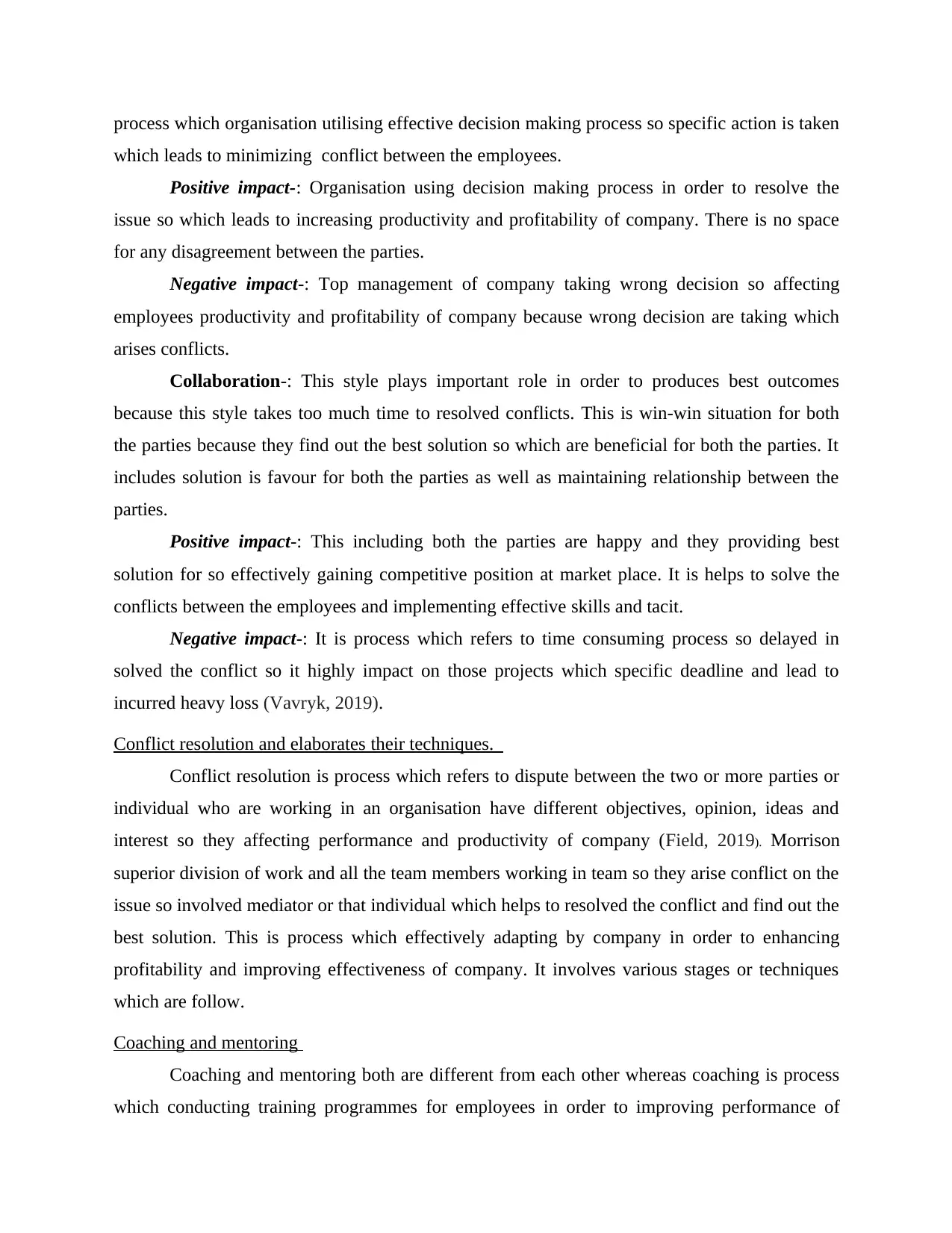
process which organisation utilising effective decision making process so specific action is taken
which leads to minimizing conflict between the employees.
Positive impact-: Organisation using decision making process in order to resolve the
issue so which leads to increasing productivity and profitability of company. There is no space
for any disagreement between the parties.
Negative impact-: Top management of company taking wrong decision so affecting
employees productivity and profitability of company because wrong decision are taking which
arises conflicts.
Collaboration-: This style plays important role in order to produces best outcomes
because this style takes too much time to resolved conflicts. This is win-win situation for both
the parties because they find out the best solution so which are beneficial for both the parties. It
includes solution is favour for both the parties as well as maintaining relationship between the
parties.
Positive impact-: This including both the parties are happy and they providing best
solution for so effectively gaining competitive position at market place. It is helps to solve the
conflicts between the employees and implementing effective skills and tacit.
Negative impact-: It is process which refers to time consuming process so delayed in
solved the conflict so it highly impact on those projects which specific deadline and lead to
incurred heavy loss (Vavryk, 2019).
Conflict resolution and elaborates their techniques.
Conflict resolution is process which refers to dispute between the two or more parties or
individual who are working in an organisation have different objectives, opinion, ideas and
interest so they affecting performance and productivity of company (Field, 2019). Morrison
superior division of work and all the team members working in team so they arise conflict on the
issue so involved mediator or that individual which helps to resolved the conflict and find out the
best solution. This is process which effectively adapting by company in order to enhancing
profitability and improving effectiveness of company. It involves various stages or techniques
which are follow.
Coaching and mentoring
Coaching and mentoring both are different from each other whereas coaching is process
which conducting training programmes for employees in order to improving performance of
which leads to minimizing conflict between the employees.
Positive impact-: Organisation using decision making process in order to resolve the
issue so which leads to increasing productivity and profitability of company. There is no space
for any disagreement between the parties.
Negative impact-: Top management of company taking wrong decision so affecting
employees productivity and profitability of company because wrong decision are taking which
arises conflicts.
Collaboration-: This style plays important role in order to produces best outcomes
because this style takes too much time to resolved conflicts. This is win-win situation for both
the parties because they find out the best solution so which are beneficial for both the parties. It
includes solution is favour for both the parties as well as maintaining relationship between the
parties.
Positive impact-: This including both the parties are happy and they providing best
solution for so effectively gaining competitive position at market place. It is helps to solve the
conflicts between the employees and implementing effective skills and tacit.
Negative impact-: It is process which refers to time consuming process so delayed in
solved the conflict so it highly impact on those projects which specific deadline and lead to
incurred heavy loss (Vavryk, 2019).
Conflict resolution and elaborates their techniques.
Conflict resolution is process which refers to dispute between the two or more parties or
individual who are working in an organisation have different objectives, opinion, ideas and
interest so they affecting performance and productivity of company (Field, 2019). Morrison
superior division of work and all the team members working in team so they arise conflict on the
issue so involved mediator or that individual which helps to resolved the conflict and find out the
best solution. This is process which effectively adapting by company in order to enhancing
profitability and improving effectiveness of company. It involves various stages or techniques
which are follow.
Coaching and mentoring
Coaching and mentoring both are different from each other whereas coaching is process
which conducting training programmes for employees in order to improving performance of
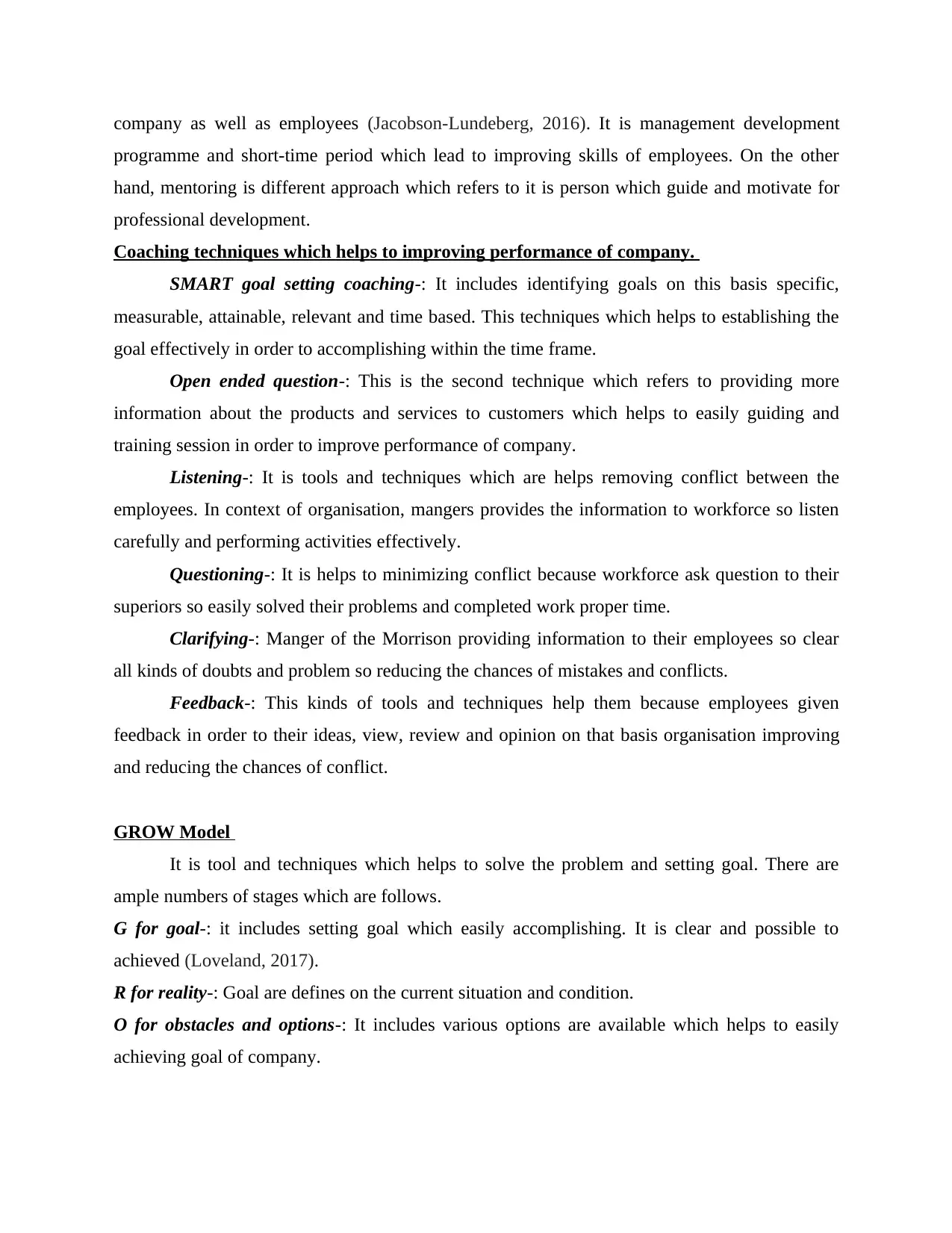
company as well as employees (Jacobson-Lundeberg, 2016). It is management development
programme and short-time period which lead to improving skills of employees. On the other
hand, mentoring is different approach which refers to it is person which guide and motivate for
professional development.
Coaching techniques which helps to improving performance of company.
SMART goal setting coaching-: It includes identifying goals on this basis specific,
measurable, attainable, relevant and time based. This techniques which helps to establishing the
goal effectively in order to accomplishing within the time frame.
Open ended question-: This is the second technique which refers to providing more
information about the products and services to customers which helps to easily guiding and
training session in order to improve performance of company.
Listening-: It is tools and techniques which are helps removing conflict between the
employees. In context of organisation, mangers provides the information to workforce so listen
carefully and performing activities effectively.
Questioning-: It is helps to minimizing conflict because workforce ask question to their
superiors so easily solved their problems and completed work proper time.
Clarifying-: Manger of the Morrison providing information to their employees so clear
all kinds of doubts and problem so reducing the chances of mistakes and conflicts.
Feedback-: This kinds of tools and techniques help them because employees given
feedback in order to their ideas, view, review and opinion on that basis organisation improving
and reducing the chances of conflict.
GROW Model
It is tool and techniques which helps to solve the problem and setting goal. There are
ample numbers of stages which are follows.
G for goal-: it includes setting goal which easily accomplishing. It is clear and possible to
achieved (Loveland, 2017).
R for reality-: Goal are defines on the current situation and condition.
O for obstacles and options-: It includes various options are available which helps to easily
achieving goal of company.
programme and short-time period which lead to improving skills of employees. On the other
hand, mentoring is different approach which refers to it is person which guide and motivate for
professional development.
Coaching techniques which helps to improving performance of company.
SMART goal setting coaching-: It includes identifying goals on this basis specific,
measurable, attainable, relevant and time based. This techniques which helps to establishing the
goal effectively in order to accomplishing within the time frame.
Open ended question-: This is the second technique which refers to providing more
information about the products and services to customers which helps to easily guiding and
training session in order to improve performance of company.
Listening-: It is tools and techniques which are helps removing conflict between the
employees. In context of organisation, mangers provides the information to workforce so listen
carefully and performing activities effectively.
Questioning-: It is helps to minimizing conflict because workforce ask question to their
superiors so easily solved their problems and completed work proper time.
Clarifying-: Manger of the Morrison providing information to their employees so clear
all kinds of doubts and problem so reducing the chances of mistakes and conflicts.
Feedback-: This kinds of tools and techniques help them because employees given
feedback in order to their ideas, view, review and opinion on that basis organisation improving
and reducing the chances of conflict.
GROW Model
It is tool and techniques which helps to solve the problem and setting goal. There are
ample numbers of stages which are follows.
G for goal-: it includes setting goal which easily accomplishing. It is clear and possible to
achieved (Loveland, 2017).
R for reality-: Goal are defines on the current situation and condition.
O for obstacles and options-: It includes various options are available which helps to easily
achieving goal of company.
⊘ This is a preview!⊘
Do you want full access?
Subscribe today to unlock all pages.

Trusted by 1+ million students worldwide
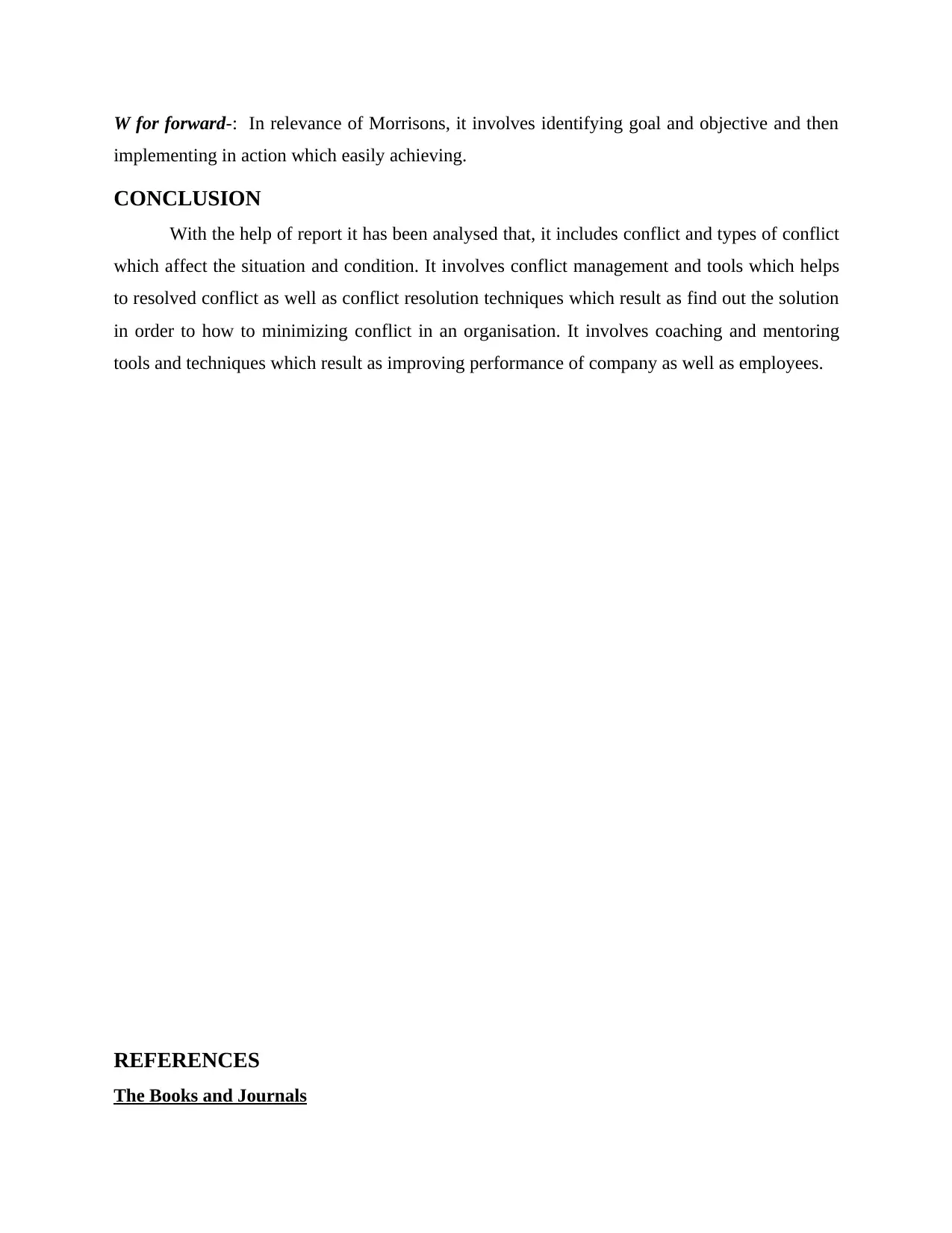
W for forward-: In relevance of Morrisons, it involves identifying goal and objective and then
implementing in action which easily achieving.
CONCLUSION
With the help of report it has been analysed that, it includes conflict and types of conflict
which affect the situation and condition. It involves conflict management and tools which helps
to resolved conflict as well as conflict resolution techniques which result as find out the solution
in order to how to minimizing conflict in an organisation. It involves coaching and mentoring
tools and techniques which result as improving performance of company as well as employees.
REFERENCES
The Books and Journals
implementing in action which easily achieving.
CONCLUSION
With the help of report it has been analysed that, it includes conflict and types of conflict
which affect the situation and condition. It involves conflict management and tools which helps
to resolved conflict as well as conflict resolution techniques which result as find out the solution
in order to how to minimizing conflict in an organisation. It involves coaching and mentoring
tools and techniques which result as improving performance of company as well as employees.
REFERENCES
The Books and Journals
Paraphrase This Document
Need a fresh take? Get an instant paraphrase of this document with our AI Paraphraser
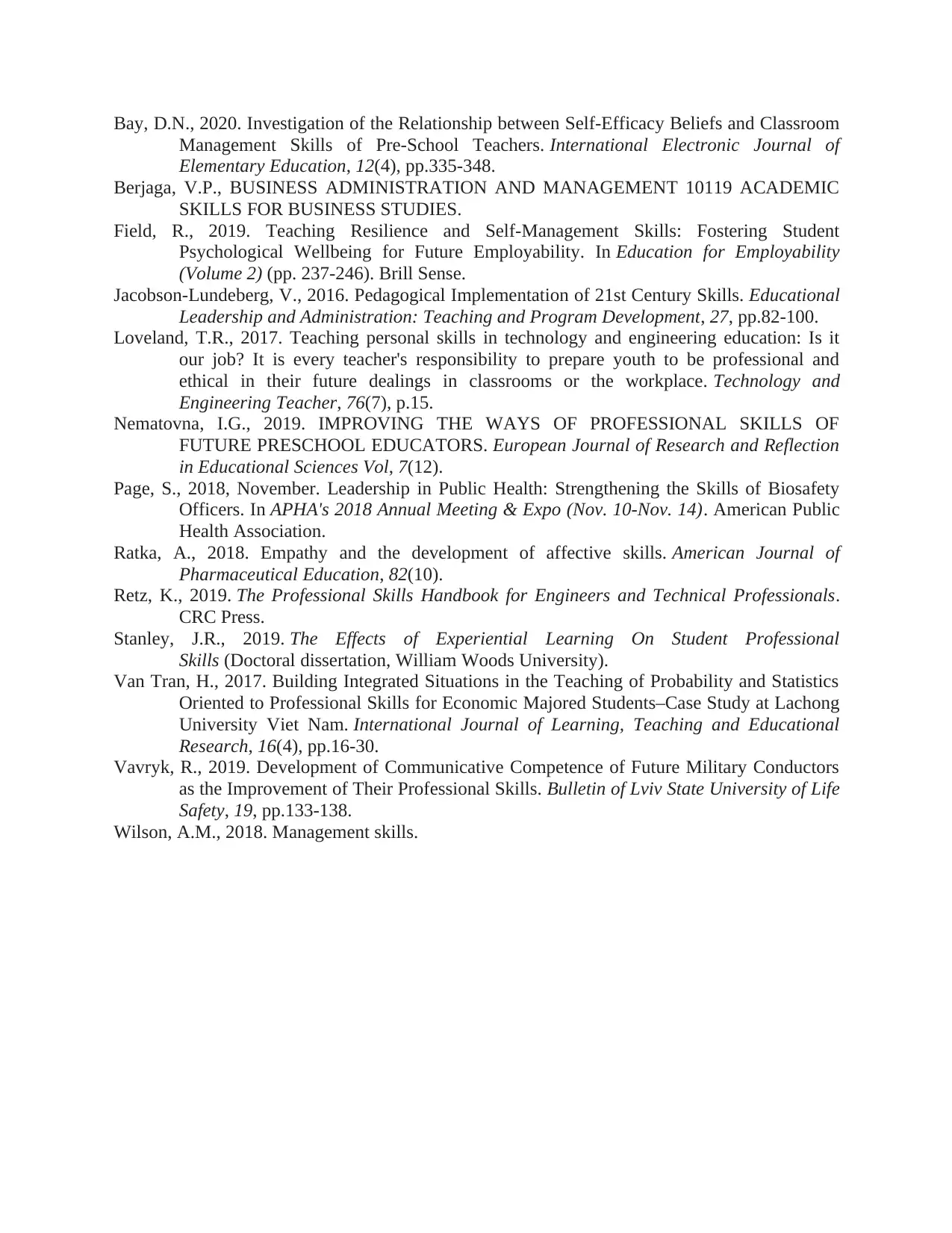
Bay, D.N., 2020. Investigation of the Relationship between Self-Efficacy Beliefs and Classroom
Management Skills of Pre-School Teachers. International Electronic Journal of
Elementary Education, 12(4), pp.335-348.
Berjaga, V.P., BUSINESS ADMINISTRATION AND MANAGEMENT 10119 ACADEMIC
SKILLS FOR BUSINESS STUDIES.
Field, R., 2019. Teaching Resilience and Self-Management Skills: Fostering Student
Psychological Wellbeing for Future Employability. In Education for Employability
(Volume 2) (pp. 237-246). Brill Sense.
Jacobson-Lundeberg, V., 2016. Pedagogical Implementation of 21st Century Skills. Educational
Leadership and Administration: Teaching and Program Development, 27, pp.82-100.
Loveland, T.R., 2017. Teaching personal skills in technology and engineering education: Is it
our job? It is every teacher's responsibility to prepare youth to be professional and
ethical in their future dealings in classrooms or the workplace. Technology and
Engineering Teacher, 76(7), p.15.
Nematovna, I.G., 2019. IMPROVING THE WAYS OF PROFESSIONAL SKILLS OF
FUTURE PRESCHOOL EDUCATORS. European Journal of Research and Reflection
in Educational Sciences Vol, 7(12).
Page, S., 2018, November. Leadership in Public Health: Strengthening the Skills of Biosafety
Officers. In APHA's 2018 Annual Meeting & Expo (Nov. 10-Nov. 14). American Public
Health Association.
Ratka, A., 2018. Empathy and the development of affective skills. American Journal of
Pharmaceutical Education, 82(10).
Retz, K., 2019. The Professional Skills Handbook for Engineers and Technical Professionals.
CRC Press.
Stanley, J.R., 2019. The Effects of Experiential Learning On Student Professional
Skills (Doctoral dissertation, William Woods University).
Van Tran, H., 2017. Building Integrated Situations in the Teaching of Probability and Statistics
Oriented to Professional Skills for Economic Majored Students–Case Study at Lachong
University Viet Nam. International Journal of Learning, Teaching and Educational
Research, 16(4), pp.16-30.
Vavryk, R., 2019. Development of Communicative Competence of Future Military Conductors
as the Improvement of Their Professional Skills. Bulletin of Lviv State University of Life
Safety, 19, pp.133-138.
Wilson, A.M., 2018. Management skills.
Management Skills of Pre-School Teachers. International Electronic Journal of
Elementary Education, 12(4), pp.335-348.
Berjaga, V.P., BUSINESS ADMINISTRATION AND MANAGEMENT 10119 ACADEMIC
SKILLS FOR BUSINESS STUDIES.
Field, R., 2019. Teaching Resilience and Self-Management Skills: Fostering Student
Psychological Wellbeing for Future Employability. In Education for Employability
(Volume 2) (pp. 237-246). Brill Sense.
Jacobson-Lundeberg, V., 2016. Pedagogical Implementation of 21st Century Skills. Educational
Leadership and Administration: Teaching and Program Development, 27, pp.82-100.
Loveland, T.R., 2017. Teaching personal skills in technology and engineering education: Is it
our job? It is every teacher's responsibility to prepare youth to be professional and
ethical in their future dealings in classrooms or the workplace. Technology and
Engineering Teacher, 76(7), p.15.
Nematovna, I.G., 2019. IMPROVING THE WAYS OF PROFESSIONAL SKILLS OF
FUTURE PRESCHOOL EDUCATORS. European Journal of Research and Reflection
in Educational Sciences Vol, 7(12).
Page, S., 2018, November. Leadership in Public Health: Strengthening the Skills of Biosafety
Officers. In APHA's 2018 Annual Meeting & Expo (Nov. 10-Nov. 14). American Public
Health Association.
Ratka, A., 2018. Empathy and the development of affective skills. American Journal of
Pharmaceutical Education, 82(10).
Retz, K., 2019. The Professional Skills Handbook for Engineers and Technical Professionals.
CRC Press.
Stanley, J.R., 2019. The Effects of Experiential Learning On Student Professional
Skills (Doctoral dissertation, William Woods University).
Van Tran, H., 2017. Building Integrated Situations in the Teaching of Probability and Statistics
Oriented to Professional Skills for Economic Majored Students–Case Study at Lachong
University Viet Nam. International Journal of Learning, Teaching and Educational
Research, 16(4), pp.16-30.
Vavryk, R., 2019. Development of Communicative Competence of Future Military Conductors
as the Improvement of Their Professional Skills. Bulletin of Lviv State University of Life
Safety, 19, pp.133-138.
Wilson, A.M., 2018. Management skills.
1 out of 11
Related Documents
Your All-in-One AI-Powered Toolkit for Academic Success.
+13062052269
info@desklib.com
Available 24*7 on WhatsApp / Email
![[object Object]](/_next/static/media/star-bottom.7253800d.svg)
Unlock your academic potential
Copyright © 2020–2025 A2Z Services. All Rights Reserved. Developed and managed by ZUCOL.





